May 27
The Battle of Oulart Hill

On this day during the Irish Rebellion of
1798, a rebel gathering of 1,000 led by
Fr. John Murphy annihilated a detachment
of militia sent from Wexford town to stamp
out the spreading rebellion in county Wexford.
When news of the long expected rising on May 23
of the United Irishmen in the midlands had reached
county Wexford, it was already in an unsettled
condition due to fears brought by the recently
instituted anti-insurgent disarmament campaign
in the county.
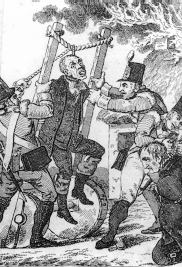
The measures used included
half-hanging, (a dry form
of waterboarding), picketing,
house burnings, and pitchcapping
to uncover rebel conspirators.

The pitchcap took the shape of a
conical cap like a clown's. It was
made of the nearest materials to
hand, whether those were hard
brown paper or stiff linen. Into
this cone, boiling pitch was poured
and the receptacle was then upturned
and pressed down on the prisoner's
head. The boiling liquid ran down
the face and into the eyes and mouth.
Sometimes the prisoner was released
with his arms still tied behind his back.
Refinements to the torture included
unbinding the victim's feet to allow
the spectacle of them running about
in agony and in some cases, deliberately
smashing their own heads in an attempt
to end the torment. His convulsive run,
together with the efforts to loosen the
torment, made spectacular sport for the
militia. On reaching a wall many victims
severely injured themselves dashing their
heads against it. The victim was on occasion
held and when the pitch had cooled the
militiamen wrenched the pitchcap off. When
militiaman or victim pulled the pitchcap off it
was accompanied by the hair and most of the
scalp. Suspects whose hair was long had their
hair cropped by shears which the North Corks
maintained for the purpose. Little finesse was
employed in that operation and ears were
frequently sheared off. Another variation
involved adding turpentine or gunpowder
to the pitchcap when cooled and then setting
it alight.
The militia reached the village of Oulart
on the afternoon of the 27th, having
refreshed themselves on the way by
sacking a suspect’s public house and
drinking the contents. Finding a mass
of 1,000 rebels occupying the high
ground of Oulart hill, they proceeded
to burn cabins at the foot of the hill
in an attempt to lure down the rebels.
The ruse failed but the nervousness of
the poorly armed rebels, among whom
there were many women and children,
was clearly visible with numbers of them
slipping away from the impending
confrontation. The rebel leaders
desperately tried to stem the tide
but had little success until the yeomen
cavalry were seen moving to positions
to cut off this escape route, which had
the effect of stemming the tide of desertions.

The militia then confidently advanced up the hill without waiting for artillery support,
contrary to orders according to one of the few survivors, the militia leader, Colonel
Foote. Unknown to the militia, the rebels had prepared an ambush line at right angles
to their position on the hill and placed those of their number with guns at the front of
their positions. The militia advanced and fired a couple of loose volleys but the rebels
held their positions until the soldiers reached killing range, then pouring concentrated
gunfire upon the soldiers. The rebels then unleashed a ferocious charge on the surviving
militiamen who were quickly overwhelmed and pursued for miles across the surrounding
countryside, only four of them escaping to the temporary safety of Wexford.

Following this victory, in which the rebels lost only six of their number, almost all of
North Wexford joined the rebellion and Crown forces and loyalists civilians ceded control
of the countryside, withdrawing to towns such as Enniscorthy, Gorey and Wexford.

Tulach a' tSolais, the ‘Mound of Light’, a national
monument to the 1798 Rising in Ireland that stands
on Oulart Hill, County Wexford. The grassy mound
is split in two with a passage that is aligned with
Vinegar Hill where the Rising was defeated.
http://youtu.be/Vc4tt_wBmqo
Día de la Madre
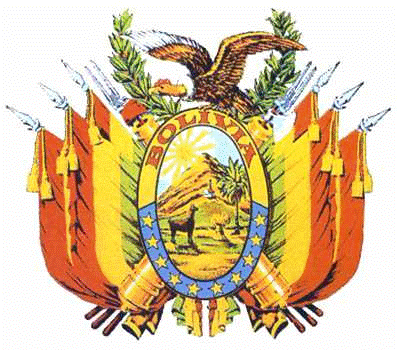
In many countries Mothers Day is celebrated on the second Sunday
of May each year. In Bolivia, Día de la Madre is celebrated on May
27th no matter what day of the week it is. People celebrate not only
their own mothers, but send congratulations, gifts and flowers to all
their friends who are mothers. Why do they celebrate Mothers Day on
May 27th?
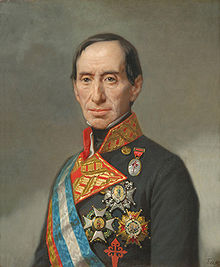
In 1812, when many regions of South
America were fighting for their
independence from Spain, the
Spanish army, led by Brigadier
General Goyeneche, had just left the
area of Cochabamba where he thought
he had squelched an insurrection. He
was headed toward Argentina to invade
various provinces that had begun to
revolt there too; however, patriots in
Cochabamba, headed by Esteban Arze,
revolted again after he had left. So he
quickly returned and soundly defeated
them.

On May 27th, with their husbands, brothers and fathers dead
or dying, the women of Cochabamba didn't hesitate to take
up arms and rise up in defense of the region. A valiant woman
named Manuela Gandarilla (who was very old and also blind)
gathered a group of women to fight against the Spaniards. They
scaled San Sebastian Hill (the Coronilla) with the rallying cry of
“Our home is sacred,” carrying the image of the Virgin of Mercy.
They hoped to block the troops, but were massacred. Spanish
troops slaughtered hundreds of women.

Three days later the city was completely occupied by the Spaniards.
All this took place on the eve of Corpus Christi (Festival of the Holy
Sacrament), and the day after the massacre, Gen. Goyeneche conducted
liturgical ceremonies as if nothing had happened. Taking advantage of
the firecrackers and fireworks to cover up the noise of the bullets, he shot
the former, patriotic governor, Mariano Antezana, and everyone he suspected
of collaborating with the revolutionaries.
For more than a century this date of Christian faith was
remembered as the “Sorrowful Festival of God.”
Bolivia eventually did achieve its independence in 1825. Two years later a
law was passed declaring May 27th as Mother's Day (also known as the "Day
of the Heroines of Coronillas") in homage to the hundreds of women who
helped defend and liberate Bolivia from Spain on a hill in Cochabamba that day.
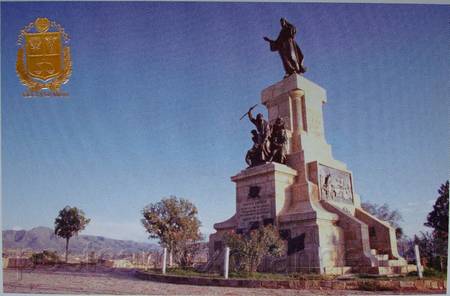
Monument to the "Heroinas de Coronillas" in Cochabamba, Bolivia
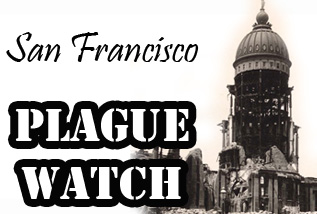
On this day in 1907, the Bubonic Plague broke out in San
Francisco. An earlier outbreak of Black Death, between
1900-1904, had killed 122 people. The 1906 earthquake
which decimated the city had forced humans and rats
alike to become refugees, leading to another outbreak
of the dreaded disease. But with hindsight on the last
epidemic and new knowledge from research, officials
launched a new kind of campaign. They offered a bounty
on rats. A similar rat-catching campaign had been used
successfully to fight plague in New Orleans. It worked as
well in San Francisco, and though this second epidemic was
stronger than the first, it was brought to halt in 1909.

Born This Day:
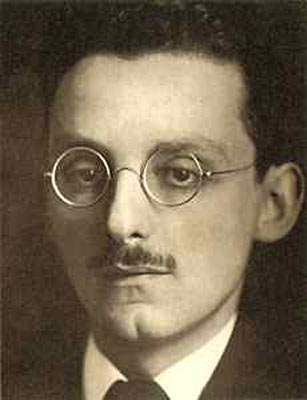
1884: Max Brod
http://youtu.be/0xI168EHj4Q

1911: Vincent Price
http://youtu.be/i6wDsmSbuUw

1935: Mal Evans (center)
http://youtu.be/4nFSG5eoAGc
http://4.bp.blogspot.com/-mtvKKY1rfEA/T ... Bsioux.jpg
1957: Siouxsie Sioux
http://youtu.be/IMyLac6txZo
Died This Day:

1840: Niccolò Paganini
http://youtu.be/OHrZAplckpI

1992: Uncle Charlie Osborne
The Battle of Oulart Hill
On this day during the Irish Rebellion of
1798, a rebel gathering of 1,000 led by
Fr. John Murphy annihilated a detachment
of militia sent from Wexford town to stamp
out the spreading rebellion in county Wexford.
When news of the long expected rising on May 23
of the United Irishmen in the midlands had reached
county Wexford, it was already in an unsettled
condition due to fears brought by the recently
instituted anti-insurgent disarmament campaign
in the county.

The measures used included
half-hanging, (a dry form
of waterboarding), picketing,
house burnings, and pitchcapping
to uncover rebel conspirators.

The pitchcap took the shape of a
conical cap like a clown's. It was
made of the nearest materials to
hand, whether those were hard
brown paper or stiff linen. Into
this cone, boiling pitch was poured
and the receptacle was then upturned
and pressed down on the prisoner's
head. The boiling liquid ran down
the face and into the eyes and mouth.
Sometimes the prisoner was released
with his arms still tied behind his back.
Refinements to the torture included
unbinding the victim's feet to allow
the spectacle of them running about
in agony and in some cases, deliberately
smashing their own heads in an attempt
to end the torment. His convulsive run,
together with the efforts to loosen the
torment, made spectacular sport for the
militia. On reaching a wall many victims
severely injured themselves dashing their
heads against it. The victim was on occasion
held and when the pitch had cooled the
militiamen wrenched the pitchcap off. When
militiaman or victim pulled the pitchcap off it
was accompanied by the hair and most of the
scalp. Suspects whose hair was long had their
hair cropped by shears which the North Corks
maintained for the purpose. Little finesse was
employed in that operation and ears were
frequently sheared off. Another variation
involved adding turpentine or gunpowder
to the pitchcap when cooled and then setting
it alight.
The militia reached the village of Oulart
on the afternoon of the 27th, having
refreshed themselves on the way by
sacking a suspect’s public house and
drinking the contents. Finding a mass
of 1,000 rebels occupying the high
ground of Oulart hill, they proceeded
to burn cabins at the foot of the hill
in an attempt to lure down the rebels.
The ruse failed but the nervousness of
the poorly armed rebels, among whom
there were many women and children,
was clearly visible with numbers of them
slipping away from the impending
confrontation. The rebel leaders
desperately tried to stem the tide
but had little success until the yeomen
cavalry were seen moving to positions
to cut off this escape route, which had
the effect of stemming the tide of desertions.

The militia then confidently advanced up the hill without waiting for artillery support,
contrary to orders according to one of the few survivors, the militia leader, Colonel
Foote. Unknown to the militia, the rebels had prepared an ambush line at right angles
to their position on the hill and placed those of their number with guns at the front of
their positions. The militia advanced and fired a couple of loose volleys but the rebels
held their positions until the soldiers reached killing range, then pouring concentrated
gunfire upon the soldiers. The rebels then unleashed a ferocious charge on the surviving
militiamen who were quickly overwhelmed and pursued for miles across the surrounding
countryside, only four of them escaping to the temporary safety of Wexford.

Following this victory, in which the rebels lost only six of their number, almost all of
North Wexford joined the rebellion and Crown forces and loyalists civilians ceded control
of the countryside, withdrawing to towns such as Enniscorthy, Gorey and Wexford.

Tulach a' tSolais, the ‘Mound of Light’, a national
monument to the 1798 Rising in Ireland that stands
on Oulart Hill, County Wexford. The grassy mound
is split in two with a passage that is aligned with
Vinegar Hill where the Rising was defeated.
http://youtu.be/Vc4tt_wBmqo
Día de la Madre

In many countries Mothers Day is celebrated on the second Sunday
of May each year. In Bolivia, Día de la Madre is celebrated on May
27th no matter what day of the week it is. People celebrate not only
their own mothers, but send congratulations, gifts and flowers to all
their friends who are mothers. Why do they celebrate Mothers Day on
May 27th?

In 1812, when many regions of South
America were fighting for their
independence from Spain, the
Spanish army, led by Brigadier
General Goyeneche, had just left the
area of Cochabamba where he thought
he had squelched an insurrection. He
was headed toward Argentina to invade
various provinces that had begun to
revolt there too; however, patriots in
Cochabamba, headed by Esteban Arze,
revolted again after he had left. So he
quickly returned and soundly defeated
them.

On May 27th, with their husbands, brothers and fathers dead
or dying, the women of Cochabamba didn't hesitate to take
up arms and rise up in defense of the region. A valiant woman
named Manuela Gandarilla (who was very old and also blind)
gathered a group of women to fight against the Spaniards. They
scaled San Sebastian Hill (the Coronilla) with the rallying cry of
“Our home is sacred,” carrying the image of the Virgin of Mercy.
They hoped to block the troops, but were massacred. Spanish
troops slaughtered hundreds of women.

Three days later the city was completely occupied by the Spaniards.
All this took place on the eve of Corpus Christi (Festival of the Holy
Sacrament), and the day after the massacre, Gen. Goyeneche conducted
liturgical ceremonies as if nothing had happened. Taking advantage of
the firecrackers and fireworks to cover up the noise of the bullets, he shot
the former, patriotic governor, Mariano Antezana, and everyone he suspected
of collaborating with the revolutionaries.
For more than a century this date of Christian faith was
remembered as the “Sorrowful Festival of God.”
Bolivia eventually did achieve its independence in 1825. Two years later a
law was passed declaring May 27th as Mother's Day (also known as the "Day
of the Heroines of Coronillas") in homage to the hundreds of women who
helped defend and liberate Bolivia from Spain on a hill in Cochabamba that day.

Monument to the "Heroinas de Coronillas" in Cochabamba, Bolivia

On this day in 1907, the Bubonic Plague broke out in San
Francisco. An earlier outbreak of Black Death, between
1900-1904, had killed 122 people. The 1906 earthquake
which decimated the city had forced humans and rats
alike to become refugees, leading to another outbreak
of the dreaded disease. But with hindsight on the last
epidemic and new knowledge from research, officials
launched a new kind of campaign. They offered a bounty
on rats. A similar rat-catching campaign had been used
successfully to fight plague in New Orleans. It worked as
well in San Francisco, and though this second epidemic was
stronger than the first, it was brought to halt in 1909.

Born This Day:

1884: Max Brod
http://youtu.be/0xI168EHj4Q

1911: Vincent Price
http://youtu.be/i6wDsmSbuUw

1935: Mal Evans (center)
http://youtu.be/4nFSG5eoAGc
http://4.bp.blogspot.com/-mtvKKY1rfEA/T ... Bsioux.jpg
1957: Siouxsie Sioux
http://youtu.be/IMyLac6txZo
Died This Day:

1840: Niccolò Paganini
http://youtu.be/OHrZAplckpI

1992: Uncle Charlie Osborne
Disclaimer: These are my opinions and not fact as realised in these here United States, lest I give my friends the idea that everyone thinks like me.
